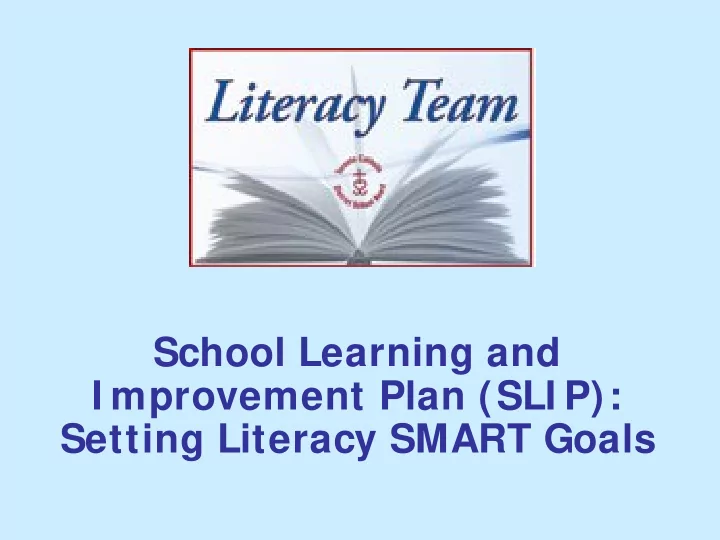

School Learning and I mprovement Plan (SLI P): Setting Literacy SMART Goals
The School Learning and I mprovement Plan • Introduction to Board Learning Improvement Plan (BLIP) and School Learning Improvement Plan (SLIP) application on intranet (September K-12 meetings) • Modelling of SLIP at K-8 meetings • DIP sessions for School Improvement Teams • Collaborative review of SLIPS (November principal meetings)
TCDSB Literacy SMART Goal To increase the number of students achieving Level 3 and 4 in Reading by 4% as measured through both the Primary and Junior EQAO Assessments in May 2010.* • Primary, from 62% 2008-2009 to 66% 2009-2010 • Junior, from 66% 2008-2009 to 70% 2009-2010 * draft SMART Goal based on Ministry of Education (MOE) goals
TCDSB Literacy SMART Goal K-6
Goal Use data from St. Elsewhere School and the Board Learning and Improvement Plan (BLIP) to model the School Learning and Improvement Plan (SLIP) process.
Detailed School Report pp. 2 and 3 Which specific area have you targeted for improvement?
Setting a Literacy K-6 SMART Goal Target for 2009-2010 Focus on: Strategies/Actions Precision Personalization
Use the following data to set your SMART Goal Target: • CAT-3 National Stanines in Reading • TCDSB Literacy Assessments (Running Records, QCA) • EQAO trends over time • 3rd term report card marks • Classroom assessments including TLCP data
Graph of CAT-3 from DI P
Dialogue Meet with grade 2 & 3, as well as grade 5 & 6 teachers, to review assessment data for each of your current grade 3 and 6 students and consider who: • will likely meet or exceed the provincial standard • will likely meet the provincial standard with targeted and precise instruction • will likely require significant intervention to meet the provincial standard
How are you measuring success in your area of concern? Which data are you examining? • Detailed School Report • Profile of Strengths and Areas of Improvement (PSAI) • Item Information Reports (IIR) • Running Record and QCA Classroom Assessments • CAT-3 Data • 3 rd term report card marks for Reading
How are you measuring success in your area of concern? What are the mid-point assessment tools/ data sources? • Teaching Learning Critical Pathway Data • Running Record Data • QCA Data • Report Card Data • Classroom Assessments
What actions/ strategies help you attain your goals? • Review Board Learning and Improvement Plan (BLIP) • Review resources • Determine actions/strategies What strategies would you suggest for St. Elsewhere to help them attain their goal? What strategies would you suggest for your school?
Actions/ Strategies • implement Literacy Learning Block daily • use TCDSB Literacy Assessments to inform and differentiate instruction • implement Gradual Release of Responsibility with a focus on Guided Reading in all classrooms
Focused Literacy I nstruction Instruct using the Gradual Release of Responsibility framework – modelled, shared/interactive, guided, independent practice using Comprehensive Literacy Handbook (TCDSB) and Literacy in the Middle Grades (TCDSB) Revise instructional plan as needed Plan on-going assessment and Focused Literacy to support student learning provide explicit feedback Instruction Gather evidence during learning to assess and analyse student progress
Actions/ Strategies • provide time for daily independent reading for all students ensuring the use of a wide range of materials • use Premier assistive technology with grade 3 and 6 students • integration of technology, drama and the arts to differentiate instruction • ensure the implementation of TLCP
Data Analysis Planning Gather evidence of student achievement based on • Determine and cluster curriculum expectations The Kindergarten Program (MOE, 2006) The • Ensure Kindergarten expectations align with the Language Curriculum (MOE, 2006) divisional TLCP expectations Analyze school data (EQAO, TCDSB Student • Identify a “big idea” that engages students Literacy Measures) in relation to ongoing classroom • Develop pre and post assessment task/question assessments • Discuss evidence-based instructional strategies Identify areas of strength and greatest need • Establish criteria • Choose resources & align instructional strategies Administer Teaching - - Learning Learning Teaching Pre-Assessment Reflection and Next Steps Critical Pathway Critical Pathway • Engage in teacher moderation Update class data chart Establish Baseline Data Discuss student achievement using collected • Review established criteria, ensuring the team has artefacts a common understanding Reflect on professional learning Engage in teacher moderation and professional Celebrate successes dialogue Discuss and plan focus of next TLCP Create class data chart and predict student progress Select “students to watch” Modify criteria if necessary Administer Post-Assessment Instruct using the Gradual Release of Responsibility framework – modelled, shared/interactive, guided, independent practice using Comprehensive Literacy Handbook (TCDSB) and Literacy in the Middle Grades (TCDSB) Revise instructional plan as needed Plan on-going assessment and to support student learning provide explicit feedback Focused Literacy Instruction Gather evidence during learning to assess and analyse student progress
I ntermediate SMART Goal Consider using: • OCA (Ontario Comprehension Assessment) data to set your Literacy SMART Goal • There will be an overall improvement of 4% in Levels 3 and 4 in the Grade 7 and 8 OCA Assessment of Reading. • Use September and February data to determine benchmark and growth.
Final Thoughts….. Thank you for your participation today! Enjoy your day!
Recommend
More recommend